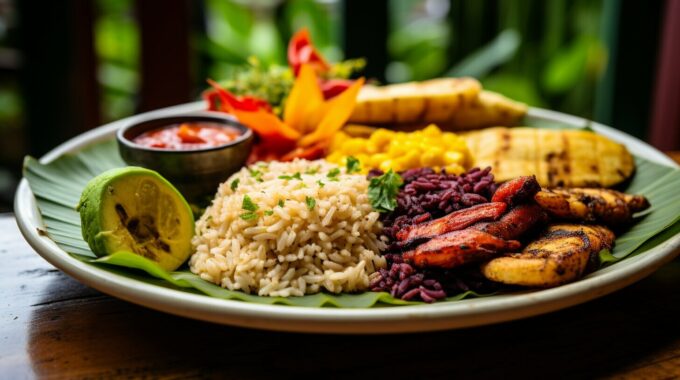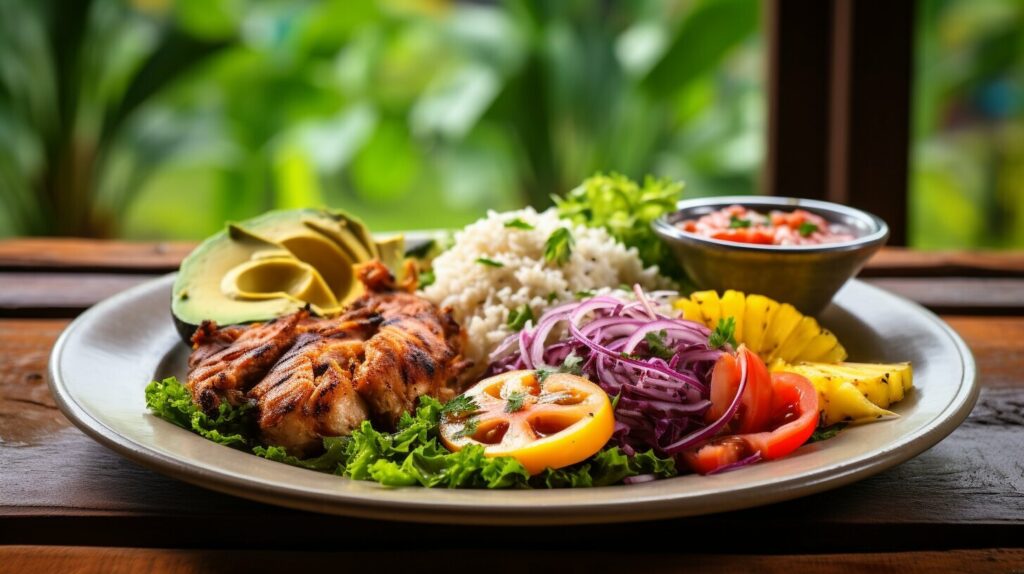At the forefront of property financing in Costa Rica, GapInvestments.com stands as a beacon for…

Exploring Costa Rica Cuisine and Food Safety: What You Need to Know
Costa Rica offers a rich culinary heritage and a commitment to food safety, making it an ideal destination for food lovers who value both taste and health. This vibrant country combines influences from various cultures, including Spanish, African, and Indigenous, resulting in a diverse and underappreciated cuisine.
The cuisine of Costa Rica relies heavily on fresh and locally sourced ingredients such as beans, plantains, yucca, and corn. Traditional dishes like gallo pinto (rice and beans), chifrijo (fried pork with red beans), casado (combo plate), and olla de carne (beef and vegetable stew) showcase the unique flavors and culinary traditions of the country.
When exploring the local cuisine in Costa Rica, it is recommended to visit sodas, which are family-style restaurants that serve authentic Costa Rican food. These establishments offer a true taste of the country’s culinary delights.
While immersing yourself in the gastronomy of Costa Rica, it is important to also practice responsible tourism and respect the environment. Costa Rica is known for its breathtaking natural beauty, and it is crucial to take steps to preserve it. Consider using rain ponchos for outdoor activities and opt for bottled water in certain areas. Engaging with the local culture through festivals, museums, and markets will further enhance your travel experience.
Key Takeaways:
- Costa Rica offers a diverse culinary experience influenced by Spanish, African, and Indigenous cultures.
- Traditional dishes like gallo pinto and casado showcase the flavors and traditions of Costa Rican cuisine.
- Try local Costa Rican food at sodas, family-style restaurants that serve authentic dishes.
- Practice responsible tourism and respect the environment while enjoying the cuisine.
- Engage with the local culture through festivals, museums, and markets for a richer travel experience.
Authentic Costa Rican Dishes and Local Ingredients
Traditional Costa Rican cuisine is a delightful fusion of flavors influenced by Spanish, African, and Indigenous cultures, featuring dishes that highlight the country’s abundance of fresh, local ingredients. Costa Rica’s culinary heritage is rich with unique and flavorful dishes that have become staples in the local diet.
One must-try dish is gallo pinto, a hearty combination of rice and beans mixed with onions, peppers, and spices. It is often enjoyed as a breakfast staple and is packed with protein and flavor. Another popular dish is chifrijo, a mouthwatering blend of fried pork, red beans, rice, and crispy tortilla chips. This savory dish is perfect for a casual lunch or an appetizer during happy hour.
If you’re looking for a more diverse meal, casado is a great choice. It is a combo plate that typically includes rice, beans, salad, plantains, and a choice of meat or fish. Casado reflects the everyday meals of Costa Rican families and offers a taste of the country’s culinary traditions. For a comforting and fulfilling option, olla de carne is a traditional beef and vegetable stew that is slow-cooked to perfection. This dish showcases the country’s farm-to-table philosophy by incorporating fresh, local ingredients.
Costa Rican cuisine prides itself on using locally sourced ingredients. Beans, plantains, yucca, and corn are staples in many dishes, providing a wholesome and satisfying eating experience. The emphasis on fresh, local ingredients not only enhances the flavor but also supports sustainable farming practices and local communities.

Truly immersing yourself in Costa Rican culture means indulging in the local cuisine. Exploring sodas, family-style restaurants that serve authentic Costa Rican food, is a must. These charming establishments offer a wide variety of traditional dishes, ensuring you experience the full range of flavors the country has to offer.
Embracing the vibrant and diverse cuisine of Costa Rica is an essential part of any trip to this beautiful country. By savoring the local dishes made with fresh, local ingredients, you can truly immerse yourself in the rich culinary heritage that Costa Rica has to offer.
Ensuring Food Safety in Costa Rica
Costa Rica prioritizes food safety through strict regulations and practices, ensuring that visitors can indulge in delicious and healthy cuisine with peace of mind. The country’s commitment to maintaining high standards in food handling and storage is evident in its comprehensive food safety regulations.
Restaurants and food establishments in Costa Rica are closely monitored and regularly inspected to ensure compliance with these regulations. They follow strict procedures for proper food storage, handling, and preparation. Staff members are trained in food safety protocols, including maintaining hygiene standards and preventing cross-contamination.
The emphasis on healthy food options is evident in Costa Rican cuisine, where fresh, locally sourced ingredients take center stage. Fruits, vegetables, and seafood are staples in many traditional dishes. The farm-to-table philosophy is deeply ingrained in the culinary culture, with an emphasis on using ingredients that are in season and sourced from local farms.
Visitors to Costa Rica can rest assured knowing that the country’s commitment to food safety extends beyond restaurants and eateries. Street vendors, markets, and sodas (family-style restaurants) also adhere to these regulations to provide safe and delicious food options.
Food Safety Measures in Costa Rica
To ensure the highest standards of food safety, Costa Rica implements measures such as:
- Regular inspection of food establishments to assess compliance with food safety regulations.
- Training programs for food handlers to educate them on proper food handling and hygiene practices.
- Implementation of Hazard Analysis Critical Control Points (HACCP) systems to identify and control potential hazards in food production.
- Monitoring and surveillance of foodborne illnesses to prevent outbreaks and ensure swift action in case of any incidents.
Additionally, Costa Rica’s rich culinary heritage is embedded in its food safety practices. Traditional culinary techniques and recipes that have been passed down through generations contribute to the overall safety and quality of the cuisine. The country’s commitment to food safety not only protects visitors from potential health risks but also preserves the authenticity and cultural significance of its culinary traditions.

| Food Safety Tips: |
|---|
| 1. Wash your hands thoroughly before and after handling food. |
| 2. Ensure that meat and seafood are cooked thoroughly to the recommended internal temperatures. |
| 3. Avoid consuming raw or undercooked food, particularly seafood and eggs. |
| 4. Stick to bottled water or ensure that tap water is properly treated before consumption. |
| 5. Choose reputable establishments with good reviews and clean food preparation areas. |
| 6. Be cautious of street vendors and ensure that their food handling practices are hygienic. |
Conclusion
Costa Rica’s cuisine is a fascinating blend of flavors that reflect the country’s rich cultural heritage, and with a focus on food safety, visitors can enjoy a culinary adventure like no other. The diverse influences from Spanish, African, and Indigenous cultures have contributed to a unique and underappreciated culinary scene.
The use of fresh and locally sourced ingredients, such as beans, plantains, yucca, and corn, is at the heart of traditional Costa Rican dishes. From the famous gallo pinto, a combination of rice and beans, to the flavorful chifrijo and the hearty olla de carne, there is a myriad of tastes to explore.
When indulging in the local cuisine, it is recommended to visit sodas, family-style restaurants that serve authentic Costa Rican food. These establishments offer a truly immersive experience in the country’s culinary traditions.
While savoring the flavors of Costa Rica, it is important to practice responsible tourism and consider the environment. Engaging with the local culture through festivals, museums, and markets will contribute to a richer travel experience. Additionally, making an effort to speak Spanish and respecting local customs will be appreciated by the friendly locals.
FAQ
Q: Is Costa Rican cuisine spicy?
A: Costa Rican cuisine is generally mild, with flavors that are more focused on freshness rather than spiciness. However, some dishes may incorporate mild to medium spiciness, so it is always good to ask about the heat level before ordering if you have a low tolerance for spice.
Q: Are vegetarian and vegan options available in Costa Rican restaurants?
A: Yes, vegetarian and vegan options are widely available in Costa Rican restaurants. Many traditional dishes can be modified to accommodate dietary preferences, and there are also dedicated vegetarian and vegan restaurants in popular tourist areas.
Q: Is it safe to eat street food in Costa Rica?
A: While street food can be a delicious way to experience local flavors, it is important to exercise caution. Look for food stalls with clean and hygienic preparation practices, with a constant stream of customers to ensure turnover of ingredients. It is best to choose cooked food that is freshly prepared in front of you.
Q: What are some popular desserts in Costa Rica?
A: Some popular Costa Rican desserts include tres leches cake (a moist cake soaked in three types of milk), arroz con leche (rice pudding), and flan (caramel custard). These sweet treats are often enjoyed after a delicious meal or as an afternoon snack.
Q: Can I drink tap water in Costa Rica?
A: While tap water is generally considered safe to drink in Costa Rica, it is recommended to stick to bottled water, especially in more remote areas. This helps to avoid any potential risk of stomach upset due to different water sources or pipes.


